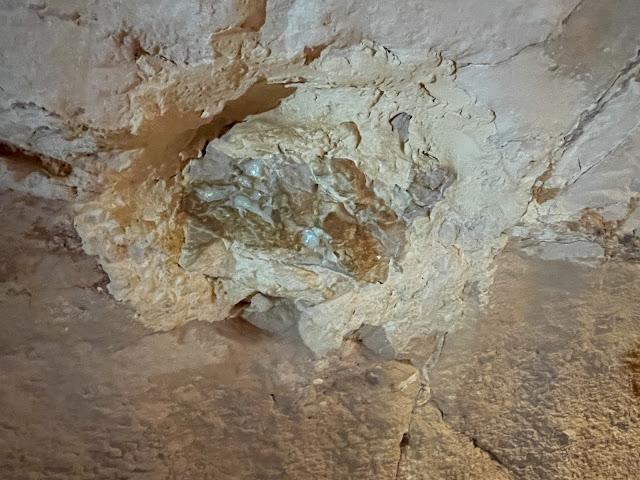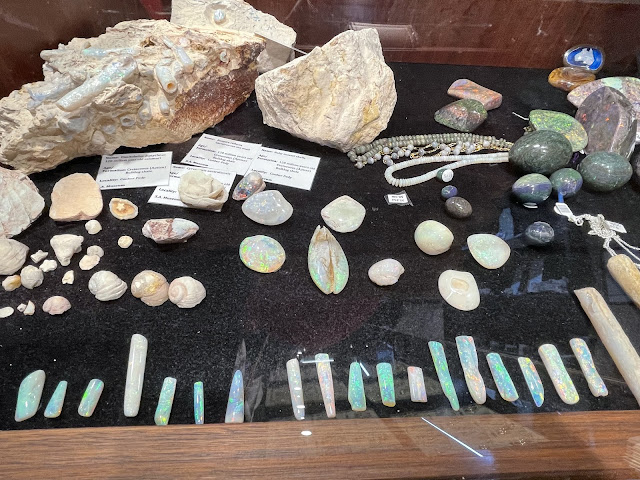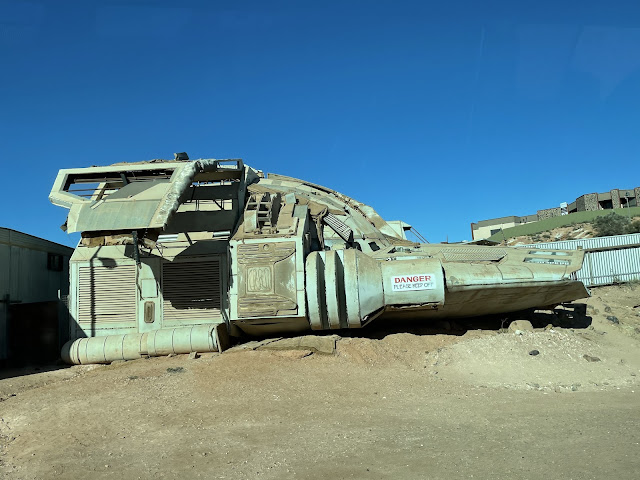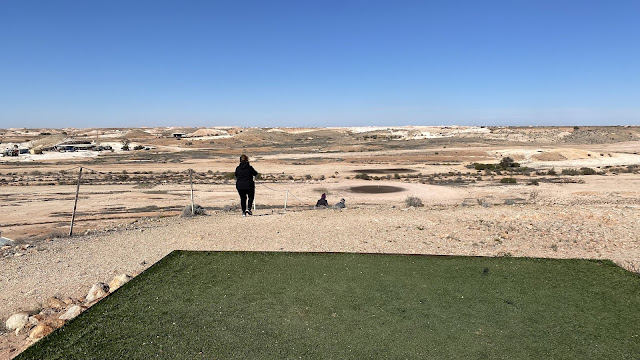We have two full days here in Coober Pedy, which is a bonus, as we are a day ahead of our very vague schedule.
Over the last few years we have started to take little tours at interesting places. This has been the best decision, as you see more than you would otherwise, and you actually learn about what you are seeing, rather than just saying “That’s nice” and not really knowing the back story. There are several different half day tours on offer here. We chose the Oasis Tours, as they have a morning tour around the town and then a second sunset tour. We opted to take both, which only cost a little more than some of the other half day tours. It was a really good decision, as the tour was small and personal. George, our guide, was laid back and informative. A perfect mix.
Our tour started at 8 o’clock in the morning, an early start due to the Ghan train being in town and between 200 and 300 passengers were being shown around the area. The first stop was the Umoons Opal Mine and Museum. It is a museum built around an original old mine started in the 1920s.
The day was sunny, but the wind had a real bight to it again. Puffer jackets and beanies were the go.
Firstly we did the guided tour underground, starting with an original dugout home dating from those early days. It was all dug out by hand. The rock is a very hard sandstone, so needs no supports. The walls are painted with a clear varnish to seal the rock.
We were taken by the temperature. It was nice and warm underground. You can see why about 50 percent of the population of 1200 choose to live underground. It is such a good insulator.
We then entered a more modern dugout home. This one had been excavated by a rock digging machine, resulting in smoother, more uniform walls.
You can see the marks made by the machines on the walls and ceiling.
This was Mick’s favourite room.
We were taken into the bedroom, where he turned out the light. It was total darkness. I think I would need a small night light on during the night.
The homes generally have a door outside through the side of a hill, which provides ventilation. The kitchen and bathroom are generally near the door. Further in the homes there are ventilation shafts through to the ground above, You can see what looks like lots of little chimneys sticking up all over the town, which are in fact ventilation shafts.
From here we were taken down some steep steps into what had been the opal mine. They estimate that there are about 700 metres of tunnels down there. It is like a labyrinth. There are no prop timbers, as the stone is stable enough on its own. They just leave pillars as supports.
The opals seem to run along horizontal seams. There was a little potch (colourless opal that is worthless) showing in the wall of one of the tunnels.
After this part of the tour, we were taken to an underground theatrette, where we saw a little movie on how opal was discovered in the area. In January 1915, a fellow by the name of Jim Hutchison was prospecting for gold in the area with two other men and his fourteen year old son Will. It was the middle of summer and they were running out of water. The men headed off one day to look for gold and water, leaving Will behind to mind the camp. Will had wandered off. When he finally returned he asked the men if they had found gold or water. They hadn’t. Will, on the other hand had found a good supply of water and a small bag full of opals. The rest, as they say, is history. After WW1, some ex-servicemen tried their luck, but it didn’t really take off. The main growth of the area was in the late 1940s to 1960s.
From here we were taken upstairs to the opal selling section. Unlike Lightning Ridge, which is the home of the black opal, Coober Pedy has white opal.
There were some very beautiful pieces on offer. Would you like some earrings (at the back) for $62,500?
I thought this display on the large opal was stunning.
This selection are actually opalised fossils.
This piece is a different type of opal again. It is crystal opal, which is translucent. On the white background it is very pale, but if you hold it against a dark background there is much more colour on show. To add to that, this piece is also an opalised fossil, which accounts for its $9,995.00 price tag.
There is more to see at the museum, but we didn’t have time. We will pop back again tomorrow.
There was a lovely bank of Sturts Desert Pea out the front of the museum.
In the vacant lot next to the museum was this contraption. It is the space ship from the movie Pitch Black which was filmed here.
The second stop on our tour was the Catholic Church of Ss Peter and Paul.
The original section took nine months to dig out by hand, work carried out by the priest and community in 1965. The current priest looks after a huge area of outback South Australia, about the size of France.
The new section up the front was dug out by machine and took nine days. What a contrast. The altar is made from zebra rock.
Looking from the inside of the church the stained glass window is stunning.
Our next stop was the Anglican “Catacomb Church”. In contrast to the Catholic Church it does not look like a church from the outside at all.
However, it too has a lovely altar area.
Next, we visited the golf course. Someone has a bit of a sense of humour.
It is a nine hole 72 par course. The “greens” are sand with sump oil sprayed over them to stabilise it. Membership is $100 per year and the club is the only one in the world with reciprocal rights with St Andrew’s in Scotland.
The tees are astroturf. You can get a good idea from here what the course looks like. Quite different to the usual. They use fluoro orange golf balls, as the white ones would be a tad hard to see in the distance.
We then drove out onto the mining area. There is no mining allowed within the town boundary. Firstly, a small prospecting shaft is drilled. If that looks promising, then a larger shaft is drilled. If that looks promising tunnelling may begin. There are loads of small mullock heaps dotting the landscape. The small ones are for the prospecting shafts. If you see larger mullock heaps, then more serious mining is taking place. You can stake a claim and it lasts for 12 months. You must work your claim and you can’t live out there.
There are signs everywhere to be mindful of open shafts. They say to never go out that way by yourself, as if you fell down a shaft you’d never be found. Apparently, you are not allowed to fill in a shaft because if someone else mined nearby and tunnelled under an old shaft it would collapse on them, as the infill would not be compacted like the rest of the rock.
Our tour concluded with a tour of another modern dugout home, which is let as tourist accommodation.
Not exactly roughing it, are they. Notice the colour in the rock walls.
As it is getting late I will finish here and share the Sunset Tour tomorrow.
I didn’t take photos of mining equipment, so will do so tomorrow and explain the process then.

































very good Janice. Keep up with the tourist novel as we all do enjoy it.
ReplyDeleteWonderful pics very interesting place
ReplyDeleteoooh such beautiful opals!
ReplyDeleteIt's amazing what a man with an pick axe can do when he puts his mind to it. I remember seeing Billy Connolly touring the underground homes when he did his world tour of Australia. The opals are fascinating, mum had several.
ReplyDeleteGorgeous opals, they are my birthstone so I'm a little biased. And yes, I have an opal ring and earrings. Our trip on the Ghan didn't stop here. We went Adelaide to Darwin, which has different stops at attractions to the north south trip. The underground homes must get nice and cool, but I wonder what it would be like living in one full time? Something you would have to get used to, I imagine.
ReplyDeletewhat a fun and interesting day...
ReplyDeleteHugz
Very interesting janice, just catching up on blogs, might be 'awhile' reading yours!
ReplyDelete